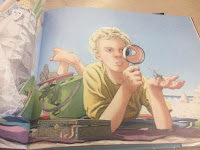(A work in progress)
Using castles to thematically teach in reading and writing:
References for kids:
I Wonder Why Castles Had Moats- Philip Steele
Castles- David Macaulay
Read alouds:
A Brave Princess- Beatrice Masini
to discuss characters
Tumble Tower- Anne Tyler
Math related:
Sir Cumference and the Round Table
- draw and measure the perimeter or circumference of tables and/or moats
Other Sir Cumference Books
How Big is a Foot?
Writing:
- Describe a castle in detail- project a photo on the board and brainstorm whole group descriptive words
- Write about the adventure of a knight
Here is a collection of ideas and activities for teaching academics to toddlers through elementary school students, based on my own teaching career as well as raising children. These are in project based and thematic learning activities, to extend traditional learning.
Translate
Thursday, January 25, 2018
Wordless Books
One unit that I like to do each year with my ELL students, is to work with wordless picture books. Sometimes we sit in a small group in a read aloud format and talk through the book together, with me doing most of the talking. At other times we each think of a line to the story as we page through the book. Some books are available on Kindle, through local library sites, or on YouTube, so that they can be projected and charted or written the board.
Later, I have students write their own versions of the story, and if they have time they can redraw the illustrations and make a book.
Wordless books are so great for integrating a number of lessons, from using strong adjectives, to story telling, writing stories, increasing vocabulary, etc.
 Here are some of our favorites:
Here are some of our favorites:
David Wiesner has a number of wordless books, most all with fantasy elements.
Tuesday is a very popular choice among the kids, but Flotsam, and Sector 7 are also fun and beautifully illustrated.
A children's librarian would have a better idea of what is locally available, but another new book that is lovely is Here I Am. Which illustrates the arrival of an immigrant child in a large city and his experience as he becomes more familiar with his surroundings.
A very cool book is Journey, by Aaron Becker. This dreamy story transports the main character through a fantasy adventure.
Pancakes for Breakfast, by Tomie DePaola, walks through the process of a grandmotherly type lady making pancakes one winter morning, beginning with collecting eggs at dawn. It embodies the humor typical of Tomie DePaola, with friendly animals.
Other titles include: The Wave by Suzy Lee, Unspoken by Henry Cole (a story of the Underground Railroad), The Flower Book by Mark Ludy, and The Girl and the Bicycle by Mark Prett.
Later, I have students write their own versions of the story, and if they have time they can redraw the illustrations and make a book.
Wordless books are so great for integrating a number of lessons, from using strong adjectives, to story telling, writing stories, increasing vocabulary, etc.
 Here are some of our favorites:
Here are some of our favorites:David Wiesner has a number of wordless books, most all with fantasy elements.
Tuesday is a very popular choice among the kids, but Flotsam, and Sector 7 are also fun and beautifully illustrated.
A children's librarian would have a better idea of what is locally available, but another new book that is lovely is Here I Am. Which illustrates the arrival of an immigrant child in a large city and his experience as he becomes more familiar with his surroundings.
A very cool book is Journey, by Aaron Becker. This dreamy story transports the main character through a fantasy adventure.
Pancakes for Breakfast, by Tomie DePaola, walks through the process of a grandmotherly type lady making pancakes one winter morning, beginning with collecting eggs at dawn. It embodies the humor typical of Tomie DePaola, with friendly animals.
Other titles include: The Wave by Suzy Lee, Unspoken by Henry Cole (a story of the Underground Railroad), The Flower Book by Mark Ludy, and The Girl and the Bicycle by Mark Prett.
Subscribe to:
Comments (Atom)


